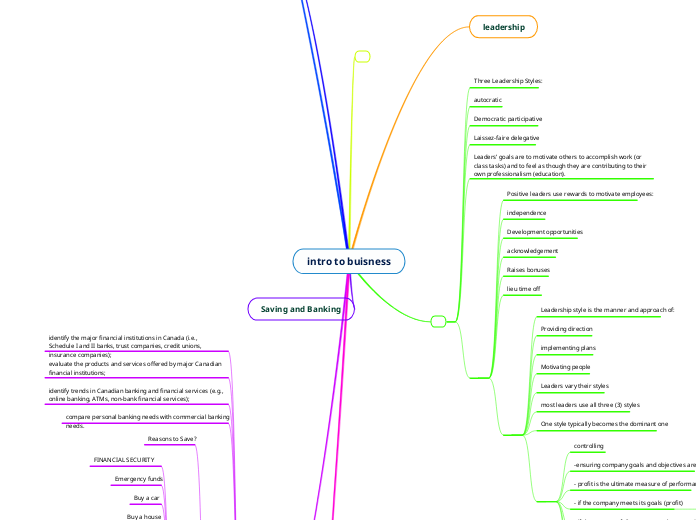intro to buisness
leadership
Three Leadership Styles:
autocratic
Democratic participative
Laissez-faire delegative
Leaders’ goals are to motivate others to accomplish work (or class tasks) and to feel as though they are contributing to their own professionalism (education).
Positive leaders use rewards to motivate employees:
independence
Development opportunities
acknowledgement
Raises bonuses
lieu time off
Leadership style is the manner and approach of:
Providing direction
implementing plans
Motivating people
Leaders vary their styles
most leaders use all three (3) styles
One style typically becomes the dominant one
controlling
-ensuring company goals and objectives are met
- profit is the ultimate measure of performance
- if the company meets its goals (profit)
- Management’s role is to duplicate it
- if the company fails to meet goals
- Management’s role is to determine why?
This process is known as evaluation
makerting
goods or services to satisfy consumer needs and wants
Marketing is the process that connects suppliers with end users
brand name: a word, or group of words, to distinguish a
businesses product from its competitors)
logo / trademark: a business combines their name with a
special symbol
The Marketing Mix- 4 P’s
Product
Place
Price
Promotion
Retail stores provide value to the products they sell
Delivery
Installation
Extended warranties
Alterations
Advice
Carry outs
Gift wrapping
When establishing price, considerations
need to be given to the unit cost price, marketing costs and distribution expenses.
Increased Selection
Alternative Choices – i.e. bad service
Better prices
Increased productivity
Product improvements
Technology advancements
Saving and Banking
identify the major financial institutions in Canada (i.e., Schedule I and II banks, trust companies, credit unions, insurance companies);
evaluate the products and services offered by major Canadian financial institutions;
identify trends in Canadian banking and financial services (e.g., online banking, ATMs, non-bank financial services);
compare personal banking needs with commercial banking needs.
Reasons to Save?
FINANCIAL SECURITY
Emergency funds
Buy a car
Buy a house
Pay for your kids to go to school
Retirement
Where to Open an Account
You can open an account at any of these financial institutions. They provide the same kinds of banking services for chequing and savings accounts, but they are run differently:
Banks and trust companies – make money for the people who own their
shares.
Credit unions – owned and run by the members who bank there. They
may charge a refundable membership fee to join.
Each of the three has its own unique features and services but they all provide regular banking services including:
chequing and savings accounts,
Safety deposit box rental
Saving bonds
loans
Mortgages
Credit
Deciding on which financial institution and which type of account you need is based on the services you want to have available to you and the amount of money you are willing to pay in fees or interest in order to have those services.
Chequing and Savings
Savings and chequing accounts are safe places
to put money you plan to spend soon:
Saving accounts – allow you to set money aside
for emergencies, save for a large purchase or
build funds for your education – while keeping
your money readily accessible.
Chequing accounts – for money that you plan to use for a day to day spending or to pay bills
